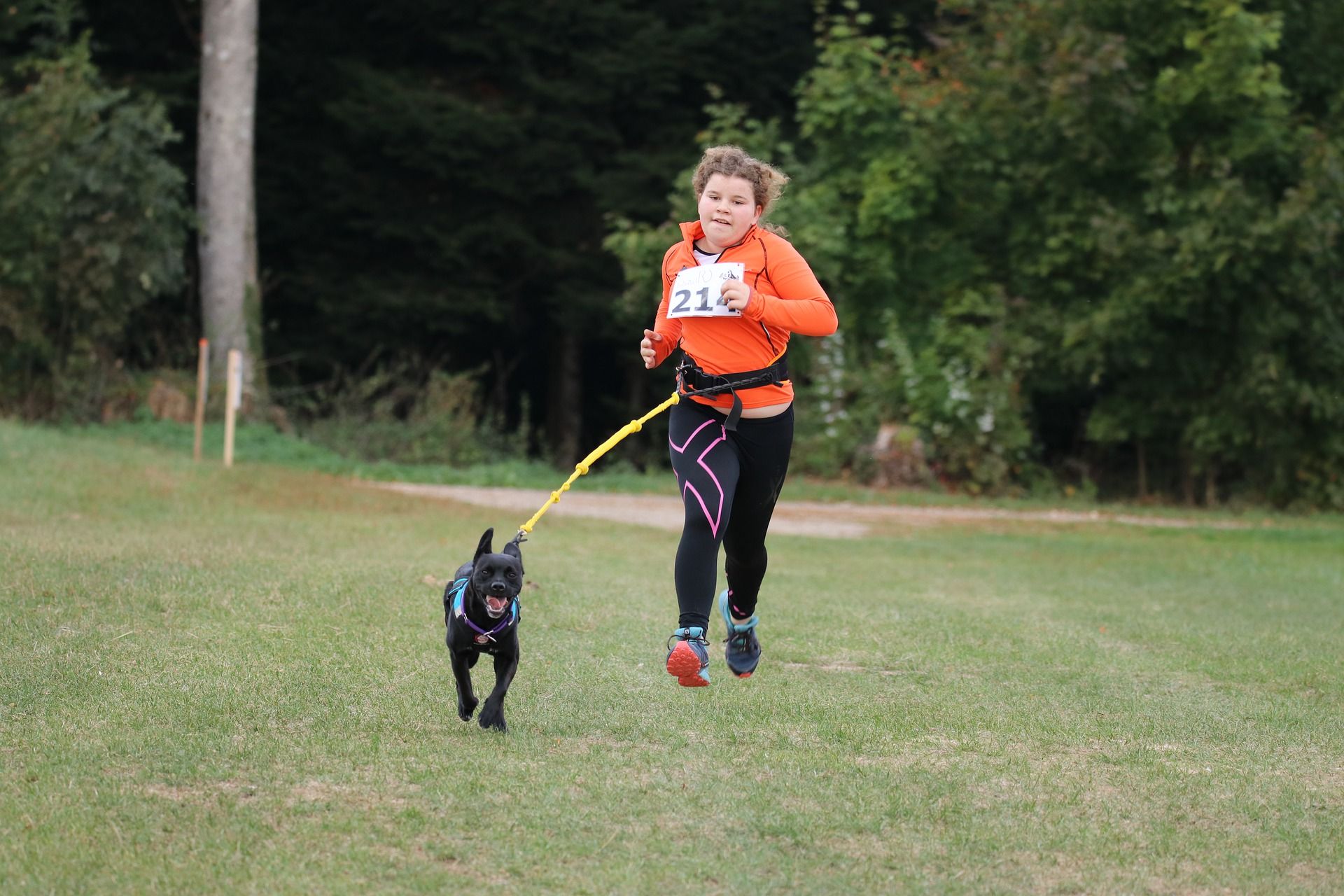Key Takeaways
Understanding the importance of advanced leash training can enhance safety and communication between you and your dog.
Choosing the right sport lead is crucial for the activities you and your dog will engage in, such as hiking or agility training.
Behavioral leash training is effective for managing and correcting issues like pulling, lunging, or reactive behaviors.
Adapting leash training techniques and gear for handlers with disabilities can provide better control and comfort.
Multi-function leashes offer versatility for various training scenarios and everyday walks.
“Human-Dog Sports for Dog Owners on the …” from www.fitbark.com and used with no modifications.
Mastering Leash Control: Beyond the Basics
When it comes to walking your furry friend, a leash is more than just a simple cord. It’s a lifeline that connects you to your dog, a tool for communication, and a means to ensure safety. But what happens when the basic leash techniques just don’t cut it anymore? That’s where advanced leash training comes into play, offering a deeper level of understanding and control that can transform your daily walks into a seamless dance between you and your pup.
Why Advanced Leash Techniques Matter
Advanced leash training is not just about keeping your dog from pulling—it’s about creating a harmonious relationship where your dog looks to you for guidance. Whether you’re navigating crowded streets or enjoying a peaceful trail, the right leash techniques can make all the difference. With advanced skills, you’ll be able to manage your dog’s behavior effectively, keeping both of you safe and making your time together enjoyable.
Enhancing Your Dog’s Safety and Your Peace of Mind
It’s not just about obedience; it’s about safety and peace of mind. A dog that’s well-trained on a leash is less likely to bolt into traffic, get into fights with other dogs, or chase wildlife. As a responsible pet owner, it’s your job to ensure that your dog can handle these situations calmly and confidently, and advanced leash training is a key component of that responsibility.
Unlock Your Dog’s Potential with Sport Leads
For the athletic pup and owner duo, sport leads are a game-changer. They’re designed to withstand the rigors of active use and provide the control needed for high-energy activities. Whether you’re training for agility, participating in flyball, or simply enjoying a run together, the right sport lead can make all the difference.
Choosing the Right Sport Lead for Your Canine Athlete
When selecting a sport lead, consider the type of activity you’ll be doing and your dog’s size and strength. A thicker, more durable lead might be necessary for larger dogs, while a lighter, more flexible lead could be better for smaller breeds. The length of the lead also matters—longer leads offer more freedom, but shorter leads give you more control.
Here’s what to keep in mind when choosing a sport lead:
The material of the leash should be durable and comfortable to hold, like nylon or leather.
Reflective stitching or colors can enhance visibility during early morning or evening activities.
A handle with padding can prevent burns or discomfort during sudden movements.
Training Techniques for Competitive Edge and Safety
Once you’ve got the right lead, it’s time to focus on training. Start with basic commands like ‘sit’, ‘stay’, and ‘come’ before progressing to more complex tasks. Always use positive reinforcement—treats, praise, and play—to reward your dog for following commands. Here are some techniques to enhance your sport lead training:
Practice direction changes and speed variations to keep your dog attentive and responsive.
Use a long line to safely train recall in open areas, gradually increasing the distance as your dog improves.
Incorporate agility equipment like jumps or tunnels to build confidence and obedience.
Remember, patience and consistency are key. Training is a journey you take with your dog, and every step forward is a triumph worth celebrating.
Implementing Positive Reinforcement and Consistency
Training your dog with a leash isn’t just about pulling and tugging—it’s about communication. Positive reinforcement is the language through which we can converse with our canine companions. It’s about rewarding the behaviors we want to encourage. Every time your dog follows a command or behaves well on the leash, mark that behavior with a treat, a clicker sound, or hearty praise. Consistency in this approach is crucial; it teaches your dog that good behavior on the leash always leads to something enjoyable.
Here’s how you can implement positive reinforcement during leash training:
Use treats that are high-value to your dog, something they don’t get at other times.
Keep training sessions short and sweet to maintain your dog’s attention and enthusiasm.
Be consistent with your commands and rewards to avoid confusing your dog.
Empowering Handlers: Adaptations for Disabilities
Every handler has unique abilities, and sometimes, standard leash techniques aren’t suitable for everyone. Handlers with disabilities can still achieve effective control and a rewarding relationship with their dog by adapting leash gear and training techniques to their needs.
Customizing Leash Gear for Unique Needs
Adaptive gear can include leashes with different grips for those with limited hand mobility, harnesses that reduce the need for bending over, or leashes that can attach to wheelchairs. The goal is to find solutions that maintain control and comfort for both the handler and the dog.
Techniques for Effective Control and Comfort
For a handler with disabilities, it’s not just about the gear—it’s also about the techniques. One might use voice commands more heavily, or rely on hand signals that are easier to deliver. Training your dog to understand these unique cues is an essential part of the process. Here are some tips:
Work with a professional trainer who has experience with adaptive training techniques.
Be patient and give your dog time to learn the new commands and gear.
Focus on building a strong bond with your dog, as trust is key to effective communication.
Multi-function Leashes: The Swiss Army Knife of Dog Walking
Just like a Swiss Army knife, multi-function leashes are versatile tools that can adapt to a variety of situations. Whether you’re training, walking in a crowded area, or out for a casual stroll, these leashes can do it all.
Transform Your Walks with Versatile Leash Designs
These innovative leashes can easily switch between different lengths, can be worn around the waist for hands-free walking, or even split into two for walking multiple dogs. The adaptability of multi-function leashes means you’re always prepared, no matter where your adventures with your dog take you.
Switching Functions: From Training to Trekking
Here’s how you can make the most out of a multi-function leash:
Use a shorter length in busy areas to keep your dog close and safe.
Extend the leash for more freedom on hikes or in parks where it’s safe to do so.
Switch to hands-free mode when you need to open doors or carry items.
With a multi-function leash, your walks become more than just a routine—they become an exercise in flexibility and preparedness.
Step-by-Step Guides: Instructional Videos
In today’s digital age, we have a wealth of information at our fingertips, and this includes step-by-step guides and instructional videos for advanced leash training. These resources can be invaluable for visual learners who benefit from seeing techniques in action.
Finding Quality Content to Enhance Training
Not all content is created equal, so it’s important to seek out videos that are produced by reputable trainers with a track record of success. Look for videos that offer clear instructions, demonstrate the techniques with a variety of dogs, and provide troubleshooting tips for common problems.
Here are some tips for finding quality instructional content:
Search for certified professional dog trainers who use positive reinforcement methods.
Check reviews and ratings from other dog owners to gauge the effectiveness of the content.
Look for videos that break down complex maneuvers into manageable steps.
Instructional videos can be a fantastic supplement to your training routine, providing fresh perspectives and techniques to help you and your dog succeed.
Exploring the Latest in High-Tech Leash Accessories
As we advance in our leash training journey, it’s exciting to see the innovations in leash technology. High-tech leash accessories are designed to improve the training experience, offering features like built-in lights for night walks, GPS trackers to monitor your dog’s location, and even smart leashes that can track your dog’s fitness levels.
Integrating New Gear into Your Training Routine
When you introduce new gear into your training routine, it’s important to do so gradually. Allow your dog to get accustomed to the new accessory without any pressure. Start by letting them inspect it and reward them for showing interest. Once they seem comfortable, incorporate the gear into your training sessions, always associating its use with positive experiences.
Essential Tips for Effective Leash Mastery
Effective leash mastery hinges on a few foundational principles: patience, consistency, and clear communication. Always start with a calm and focused mindset, as dogs are incredibly perceptive of our emotions and will react accordingly. Use commands that are short and distinct, and always follow through with immediate praise or correction. Remember, the goal is to make the leash a symbol of your bond and mutual respect, not just a tool for restraint.
Frequently Asked Questions (FAQ)
There are always questions when it comes to refining leash skills, and that’s a good thing—it shows a commitment to learning and growth. Let’s tackle some of the most common queries to help further enhance your leash training knowledge.
How Do I Choose the Right Sport Lead for My Dog?
Choosing the right sport lead depends on several factors, including your dog’s breed, size, and the type of activities you plan to engage in. Look for a lead that is strong enough to handle your dog’s power but light enough not to hinder their movements. Consider a lead with a comfortable grip for you and, if necessary, one that has quick-release features for sports that require agility and flexibility.
Can Behavioral Leash Training Help with Aggression?
Absolutely. Behavioral leash training is a powerful tool for managing aggression. It allows you to safely control your dog and prevent negative behaviors before they escalate. Training provides mental stimulation and can reduce anxiety, which often contributes to aggression. By setting clear boundaries and using positive reinforcement, you can teach your dog to respond calmly in situations that previously triggered an aggressive response. For more detailed guidance, check out our dog separation anxiety relief training guide which includes tips for calm pets and can complement behavioral leash training strategies.
What Are Some Leash Adaptations for Handlers with Disabilities?
Handles with ergonomic designs or padding for a comfortable grip.
Leashes with adjustable lengths that can be altered without bending down.
Hands-free leashes that can be worn around the waist or across the body.
How Do Multi-function Leashes Work?
Multi-function leashes are designed with versatility in mind. They typically have several clips along the leash, as well as D-rings or loops, which allow you to shorten or lengthen the leash, convert it into a harness, or even create a temporary tie-out. These leashes are perfect for adapting to different environments and training scenarios without the need to switch gear.
Advanced leash techniques are essential for managing pets in various scenarios. Whether you’re dealing with dogs with traumatic pasts, training for sports, or adapting leashes for pets with disabilities, understanding the full range of leash uses can greatly enhance your pet’s safety and your peace of mind. Multi-function leashes and instructional videos can also provide additional guidance, while adaptive gear can help accommodate specific needs.





